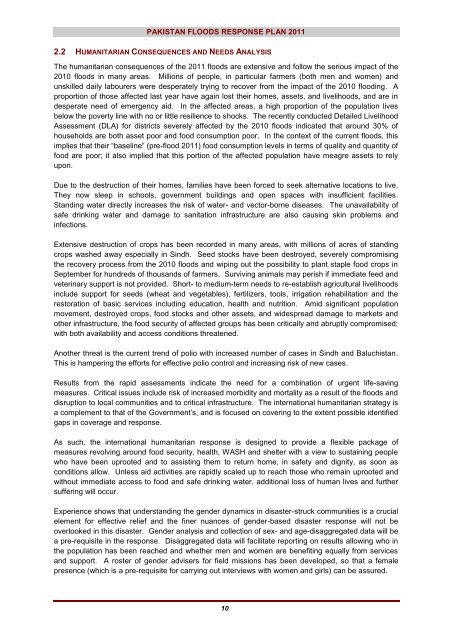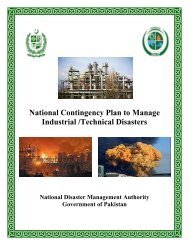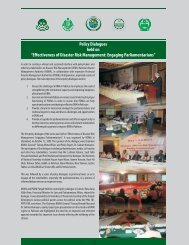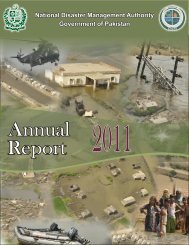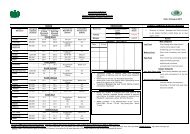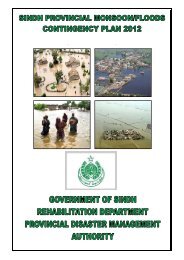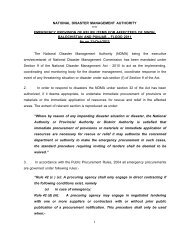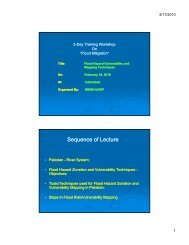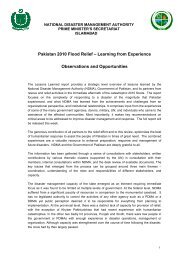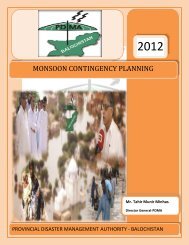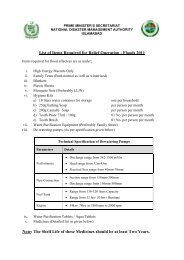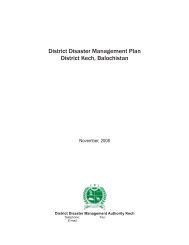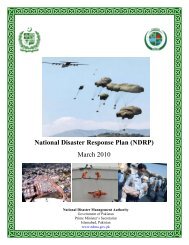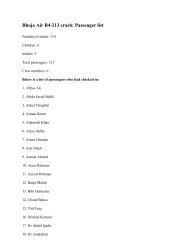Pakistan Floods 2011 - Humanitarian Response
Pakistan Floods 2011 - Humanitarian Response
Pakistan Floods 2011 - Humanitarian Response
- No tags were found...
You also want an ePaper? Increase the reach of your titles
YUMPU automatically turns print PDFs into web optimized ePapers that Google loves.
PAKISTAN FLOODS RESPONSE PLAN <strong>2011</strong>9B2.2 HUMANITARIAN CONSEQUENCES AND NEEDS ANALYSISThe humanitarian consequences of the <strong>2011</strong> floods are extensive and follow the serious impact of the2010 floods in many areas. Millions of people, in particular farmers (both men and women) andunskilled daily labourers were desperately trying to recover from the impact of the 2010 flooding. Aproportion of those affected last year have again lost their homes, assets, and livelihoods, and are indesperate need of emergency aid. In the affected areas, a high proportion of the population livesbelow the poverty line with no or little resilience to shocks. The recently conducted Detailed LivelihoodAssessment (DLA) for districts severely affected by the 2010 floods indicated that around 30% ofhouseholds are both asset poor and food consumption poor. In the context of the current floods, thisimplies that their “baseline” (pre-flood <strong>2011</strong>) food consumption levels in terms of quality and quantity offood are poor; it also implied that this portion of the affected population have meagre assets to relyupon.Due to the destruction of their homes, families have been forced to seek alternative locations to live.They now sleep in schools, government buildings and open spaces with insufficient facilities.Standing water directly increases the risk of water- and vector-borne diseases. The unavailability ofsafe drinking water and damage to sanitation infrastructure are also causing skin problems andinfections.Extensive destruction of crops has been recorded in many areas, with millions of acres of standingcrops washed away especially in Sindh. Seed stocks have been destroyed, severely compromisingthe recovery process from the 2010 floods and wiping out the possibility to plant staple food crops inSeptember for hundreds of thousands of farmers. Surviving animals may perish if immediate feed andveterinary support is not provided. Short- to medium-term needs to re-establish agricultural livelihoodsinclude support for seeds (wheat and vegetables), fertilizers, tools, irrigation rehabilitation and therestoration of basic services including education, health and nutrition. Amid significant populationmovement, destroyed crops, food stocks and other assets, and widespread damage to markets andother infrastructure, the food security of affected groups has been critically and abruptly compromised;with both availability and access conditions threatened.Another threat is the current trend of polio with increased number of cases in Sindh and Baluchistan.This is hampering the efforts for effective polio control and increasing risk of new cases.Results from the rapid assessments indicate the need for a combination of urgent life-savingmeasures. Critical issues include risk of increased morbidity and mortality as a result of the floods anddisruption to local communities and to critical infrastructure. The international humanitarian strategy isa complement to that of the Government‟s, and is focused on covering to the extent possible identifiedgaps in coverage and response.As such, the international humanitarian response is designed to provide a flexible package ofmeasures revolving around food security, health, WASH and shelter with a view to sustaining peoplewho have been uprooted and to assisting them to return home, in safety and dignity, as soon asconditions allow. Unless aid activities are rapidly scaled up to reach those who remain uprooted andwithout immediate access to food and safe drinking water, additional loss of human lives and furthersuffering will occur.Experience shows that understanding the gender dynamics in disaster-struck communities is a crucialelement for effective relief and the finer nuances of gender-based disaster response will not beoverlooked in this disaster. Gender analysis and collection of sex- and age-disaggregated data will bea pre-requisite in the response. Disaggregated data will facilitate reporting on results allowing who inthe population has been reached and whether men and women are benefiting equally from servicesand support. A roster of gender advisers for field missions has been developed, so that a femalepresence (which is a pre-requisite for carrying out interviews with women and girls) can be assured.10


